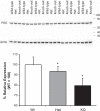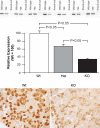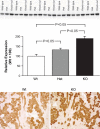NBCe1 expression is required for normal renal ammonia metabolism
- PMID: 26224717
- PMCID: PMC4593816
- DOI: 10.1152/ajprenal.00219.2015
NBCe1 expression is required for normal renal ammonia metabolism
Abstract
The mechanisms regulating proximal tubule ammonia metabolism are incompletely understood. The present study addressed the role of the proximal tubule basolateral electrogenic Na(+)-coupled bicarbonate cotransporter (NBCe1; Slc4a4) in renal ammonia metabolism. We used mice with heterozygous and homozygous NBCe1 gene deletion and compared these mice with their wild-type littermates. Because homozygous NBCe1 gene deletion causes 100% mortality before day 25, we studied mice at day 8 (±1 day). Both heterozygous and homozygous gene deletion caused a gene dose-related decrease in serum bicarbonate. The ability to lower urinary pH was intact, and even accentuated, with NBCe1 deletion. However, in contrast to the well-known effect of metabolic acidosis to increase urinary ammonia excretion, NBCe1 deletion caused a gene dose-related decrease in ammonia excretion. There was no identifiable change in proximal tubule structure by light microscopy. Examination of proteins involved in renal ammonia metabolism showed decreased expression of phosphate-dependent glutaminase and phosphoenolpyruvate carboxykinase, key enzymes in proximal tubule ammonia generation, and increased expression of glutamine synthetase, which recycles intrarenal ammonia and regenerates glutamine. Expression of key proteins involved in ammonia transport outside of the proximal tubule (rhesus B glycoprotein and rhesus C glycoprotein) was not significantly changed by NBCe1 deletion. We conclude from these findings that NBCe1 expression is necessary for normal proximal tubule ammonia metabolism.
Keywords: acid-base; ammonia; electrogenic sodium-coupled bicarbonate cotransporter 1; proximal tubule.
Figures








Similar articles
-
NBCe1-A Regulates Proximal Tubule Ammonia Metabolism under Basal Conditions and in Response to Metabolic Acidosis.J Am Soc Nephrol. 2018 Apr;29(4):1182-1197. doi: 10.1681/ASN.2017080935. Epub 2018 Feb 26. J Am Soc Nephrol. 2018. PMID: 29483156 Free PMC article.
-
Acid-base effects of combined renal deletion of NBCe1-A and NBCe1-B.Am J Physiol Renal Physiol. 2022 Feb 1;322(2):F208-F224. doi: 10.1152/ajprenal.00358.2021. Epub 2022 Jan 10. Am J Physiol Renal Physiol. 2022. PMID: 35001662 Free PMC article.
-
Role of the renal androgen receptor in sex differences in ammonia metabolism.Am J Physiol Renal Physiol. 2021 Nov 1;321(5):F629-F644. doi: 10.1152/ajprenal.00260.2021. Epub 2021 Oct 4. Am J Physiol Renal Physiol. 2021. PMID: 34605272 Free PMC article.
-
Recent advances in understanding renal ammonia metabolism and transport.Curr Opin Nephrol Hypertens. 2016 Sep;25(5):436-43. doi: 10.1097/MNH.0000000000000255. Curr Opin Nephrol Hypertens. 2016. PMID: 27367914 Free PMC article. Review.
-
Role of NH3 and NH4+ transporters in renal acid-base transport.Am J Physiol Renal Physiol. 2011 Jan;300(1):F11-23. doi: 10.1152/ajprenal.00554.2010. Epub 2010 Nov 3. Am J Physiol Renal Physiol. 2011. PMID: 21048022 Free PMC article. Review.
Cited by
-
Effect of NBCe1 deletion on renal citrate and 2-oxoglutarate handling.Physiol Rep. 2016 Apr;4(8):e12778. doi: 10.14814/phy2.12778. Physiol Rep. 2016. PMID: 27117802 Free PMC article.
-
Sex differences in renal ammonia metabolism.Am J Physiol Renal Physiol. 2021 Jan 1;320(1):F55-F60. doi: 10.1152/ajprenal.00531.2020. Epub 2020 Dec 14. Am J Physiol Renal Physiol. 2021. PMID: 33308019 Free PMC article.
-
Emerging Features of Ammonia Metabolism and Transport in Acid-Base Balance.Semin Nephrol. 2019 Jul;39(4):394-405. doi: 10.1016/j.semnephrol.2019.04.008. Semin Nephrol. 2019. PMID: 31300094 Free PMC article. Review.
-
Proximal tubule glutamine synthetase expression is necessary for the normal response to dietary protein restriction.Am J Physiol Renal Physiol. 2017 Jul 1;313(1):F116-F125. doi: 10.1152/ajprenal.00048.2017. Epub 2017 Mar 22. Am J Physiol Renal Physiol. 2017. PMID: 28331060 Free PMC article.
-
Smooth muscle AKG/OXGR1 signaling regulates epididymal fluid acid-base balance and sperm maturation.Life Metab. 2022 Jul 14;1(1):67-80. doi: 10.1093/lifemeta/loac012. eCollection 2022 Aug. Life Metab. 2022. PMID: 39872683 Free PMC article.
References
-
- Aalkjaer C, Frische S, Leipziger J, Nielsen S, Praetorius J. Sodium coupled bicarbonate transporters in the kidney, an update. Acta Physiol Scand 181: 505–512, 2004. - PubMed
-
- Ambuhl PM, Amemiya M, Danczkay M, Lotscher M, Kaissling B, Moe OW, Preisig PA, Alpern RJ. Chronic metabolic acidosis increases NHE3 protein abundance in rat kidney. Am J Physiol Renal Fluid Electrolyte Physiol 271: F917–F925, 1996. - PubMed
-
- Baum M, Biemesderfer D, Gentry D, Aronson PS. Ontogeny of rabbit renal cortical NHE3 and NHE1: effect of glucocorticoids. Am J Physiol Renal Fluid Electrolyte Physiol 268: F815–F820, 1995. - PubMed
-
- Benchimol C, Zavilowitz B, Satlin LM. Developmental expression of ROMK mRNA in rabbit cortical collecting duct. Pediatr Res 47: 46–52, 2000. - PubMed
Publication types
MeSH terms
Substances
Grants and funding
LinkOut - more resources
Full Text Sources
Other Literature Sources
Molecular Biology Databases

